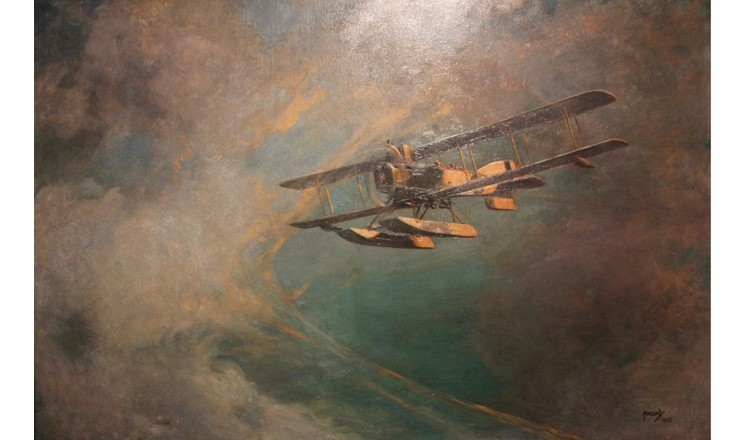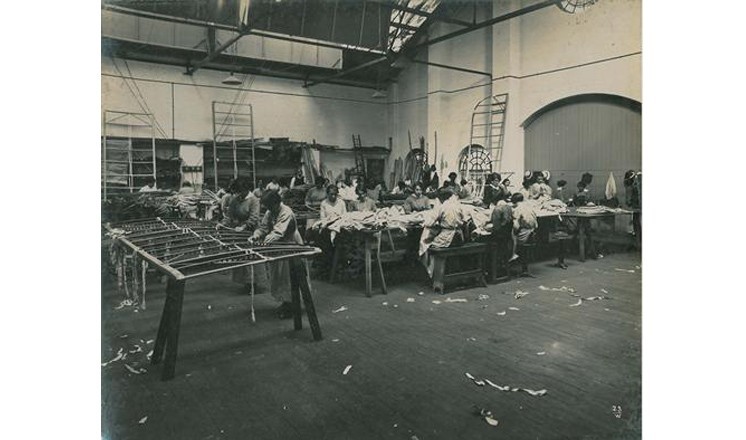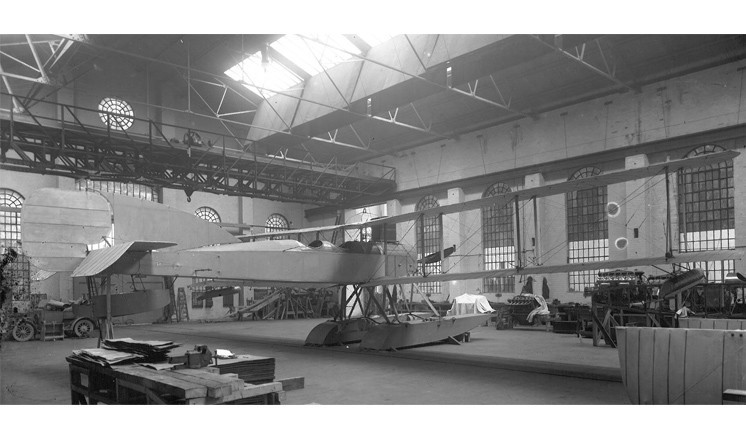Hassall’s seaplane painting revealed after restoration
RSS Feed
The Painting
This atmospheric painting of a seaplane was painted in 1915, the first year of its manufacture, and shows the seaplane alone in a stormy sky. The painting was loaned to Lincolnshire County Council in 1984 by Robey & Co. but unfortunately the canvas had a small tear in it, just above the signature, the surface had become dull with discolouration of the varnish and surface dirt, and the frame had small areas of damage. In 2014 the Friends of Lincoln Museums and Art Gallery kindly donated funds to enable the painting to be conserved. In order to repair the tear the varnish had to be removed from the whole surface of the painting, and the surface itself cleaned. Following the repair of the tear, the painting was re-varnished, the frame was also cleaned and repaired and the results are stunning. This has allowed us to display the work in the Usher Gallery in the seaplane's centenary year.
The Artist
The artist John Hassall (1868-1948) painted this magnificent oil painting of a Short 184 seaplane. In the early 1890s Hassall attended the Antwerp Academy and the Académie Julian in Paris. He exhibited at the Royal Academy and elsewhere, and worked as a black and white artist (chiefly for The Sketch from 1893-1912) and designed many decorative friezes and panels. He found his true vocation as a poster designer, working on contract to the printers David Allen for seven years, and is probably most associated with his railway poster featuring the Jolly Fisherman and the phrase 'Skegness is so bracing'.
The Seaplane
The Short Type 184 seaplane was a two seat reconnaissance, bombing and torpedo carrying seaplane. Designed by Short Brothers of Rochester, England it fulfilled an urgent need of the British Admiralty and first flew in early 1915.
The Short 184 became the first aeroplane to sink a ship with a torpedo, when Flight Commander Charles Edmonds torpedoed a Turkish transport vessel a few miles north of the Dardanelles. The Short 184 became the workhorse of the Admiralty, and was principally used in anti-submarine patrol work, but although a considerable number of submarines were spotted and attacked, no U-boats were actually sunk. It remained in active service until the end of the First World War.
936 aircraft were built by 10 different British aircraft manufacturers, including Robey & Co. The firm Robey was founded in Lincoln in 1854 by Robert Robey, making portable steam engines and thrashing machines, and became Robey & Co. Ltd. in 1893. The firm expanded rapidly, and by the turn of the century the Globe Works site on Canwick Road covered 15 acres, manufacturing products that included traction engines, portable engines, thrashing machines, road rollers, winding gear and stone crushing equipment.
Robey's made a considerable contribution to the war effort and between November 1915 and November 1918 manufactured 256 Short 184 seaplanes in the Globe Works (now Jackson's Building Centre). The aircraft were erected in new shops behind the main Canwick Road Works.
As an aside, there is an interesting story relating to seaplanes from the First World War. To aid communication between the crew and the shore base, seaplanes were equipped with two carrier pigeons in a box; vital if primitive radio equipment did not work or was damaged by seawater if the plane had to ditch. However, the pigeons themselves were not the most reliable method of communication as RNAS pilot F Silwood recalled, the birds were sometimes reluctant to take to the air:
"My engine conked out and we made a pancake landing against a big wave. We released our pigeons. The trouble was that it was blowing so hard the pigeons wouldn't leave the aeroplane. So we threw everything we had at them – I threw my last half crown at them! They eventually got back to the loft and a half crown was never better spent because 16 hours afterwards we were picked up."
Watch a film clip from the Imperial War Museum here.
Images
Oil on canvas, John Hassall, A Short Seaplane, 1915, on loan from Robey & Co. Lincoln
Photograph, Women preparing the wings for canvassing for the Robey Seaplane, courtesy Lincolnshire Archives (ROBEY/1/9/1/2/2)
Photograph, A Short 184 inside one of Robey & Company’s workshops, c1918, courtesy Lincolnshire Archives (30 MLL 8/4)
With thanks to Lincolnshire Archives for the Robey photographs and information on the seaplane pigeons.
Comments
There aren’t any comments for this blog yet



